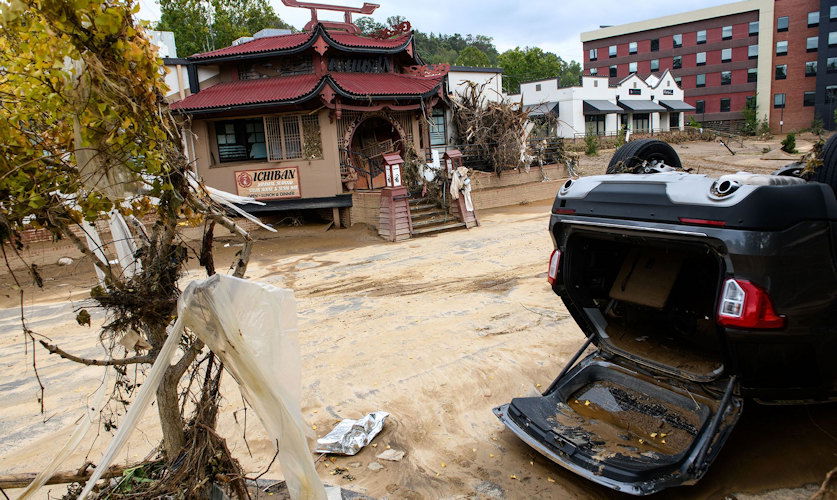People moved to Asheville to escape extreme weather. They forgot its tragic history.

(CNN) — Asheville was touted as a climate haven, a place to escape the worst ravages of extreme weather. But Hurricane Helene’s deadly path of destruction reveals this North Carolina city, like any in America, was never safe — it’s just that memories are short and the reach of the climate crisis is consistently underestimated.
“If you live in a place that can rain, you live in a place that can flood,” said Kathie Dello, North Carolina’s state climatologist. The past week has shown that reality starkly.
After Hurricane Helene made landfall in Florida as a Category 4 hurricane on Thursday, it raged northward and inflicted widespread devastation across six states, killing more than 160 people.
It pummeled western North Carolina as a tropical storm Friday. In Buncombe County, where Asheville is the county seat, more than 50 people have died and many more remain missing.
Asheville, home to about 95,000 people, lies decimated. Highways are torn up and power lines strewn like spaghetti. People are struggling to access food, water and electricity.
Residents have likened Helene’s aftermath to a “war zone;” officials have described it as “post-apocalyptic.”
It’s all a far cry from the image that some media outlets, real estate agents and residents painted of Asheville, located hundreds of miles from the Atlantic Ocean and Gulf of Mexico: a place relatively safe from the climate extremes affecting other parts of the US.
So-called climate migrants have long been arriving here from places like California, Arizona and the coastal Carolinas, said Jesse Keenan, associate professor of sustainable real estate and urban planning at Tulane University.
In online forums discussing where to escape heat, floods and fire, Asheville consistently comes up. One poster wrote in 2019, they didn’t want “to be in a place that has constant threat of natural disasters that will destroy our property so we are planning on moving to (the) Asheville area.”
Even the climate experts who call Asheville home believed they were insulated from the worst risks. Susan Hassol, a veteran climate change communicator and science writer, said she and others “have labored under the illusion that we live in a relatively climate-safe place.”
But in a world reshaped by human-caused global warming, no place is truly safe and Helene had the “fingerprints of climate change” all over it, Dello told CNN.
The hurricane formed and traveled over the exceptionally warm waters of the Gulf, which allowed it “to really juice up and grow,” she said. A warmer atmosphere can also hold more water, allowing it to wring out more torrential rain.
A rapid climate analysis published Tuesday by scientists from Lawrence Berkeley National Laboratory found fossil fuel pollution caused over 50% more rainfall in parts of Georgia and the Carolinas. It also estimated global warming made the rain in these regions 20 times more likely.
In some ways, this scenic swath of western North Carolina was primed for catastrophe.
Much of Buncombe County is shaped like a bowl, meaning torrential rain can quickly funnel down and inundate neighborhoods. “It’s a mountainous area, and the hill slopes are very steep. It doesn’t take a lot of rain to cause a landslide,” Dello said.
Asheville, in the foothills of the Blue Ridge mountains and at the intersection of two major rivers — the French Broad and the Swannanoa — is vulnerable to flooding, as a long history attests.
In 1916, back-to-back hurricanes dumped relentless rain on Asheville and other parts of western North Carolina, triggering biblical flooding that washed away houses and killed around 80 people.
Almost exactly the same scenario played out in 2004, when tropical storms Ivan and Frances tracked along the Appalachians. Both systems concentrated their highest rainfall on western North Carolina, killing 11 people.
More recently, Tropical Storm Fred caused catastrophic flooding in 2021, prompting a major disaster declaration.
Asheville has historically been susceptible to impacts from heavy rain, but the severity of Helene “seemingly caught people off guard,” said Ed Kearns, chief data officer at First Street Foundation, a non-profit focused on weather risk research.
He attributed this to a tendency to rely on past experiences that are no longer relevant in a changing climate. “Risks are increasing more than we as humans can perceive,” Kerns told CNN.
A recent First Street report found parts of North Carolina devastated by Helene could now experience a once-in-100 year flood every 11 to 25 years.
As the waters recede, the process of rebuilding Asheville starts. “I can’t even think about a time frame for how long it’s going to take to recover,” Asheville Mayor Esther Manheimer said Monday.
But, while Helene may have undone the idea of a “climate-safe” city, Tulane University’s Keenan does not believe it will ultimately dampen people’s desire to move here. “I think this is actually going to accelerate this process,” he said.
In a tragic twist, disasters like hurricanes “clean the slate” for developers and investors to come from outside and buy up properties relatively cheaply to redevelop into denser, more expensive homes, Keenan said.
“People have pretty short memories on this stuff. There are always people who are willing to take a risk,” he said. “This is the story of American post-disaster development.”
There’s also the sense that there is nowhere else to go.
The risks are everywhere. “Canada has fires, Vermont floods, West Virginia has severe drought, there are heat issues in Phoenix,” Dello said.
“Where do you run from climate change?”
CNN’s Rachel Ramirez, Ella Nilsen and Brandon Miller contributed reporting
The-CNN-Wire
™ & © 2024 Cable News Network, Inc., a Warner Bros. Discovery Company. All rights reserved.